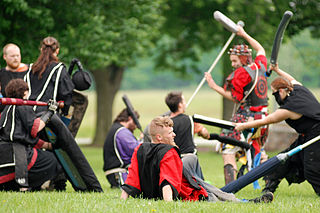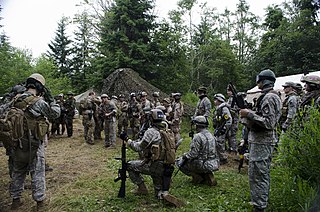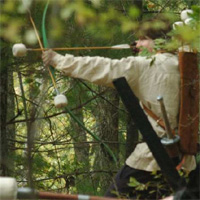
A live action role-playing game (LARP) is a form of role-playing game where the participants physically portray their characters. The players pursue goals within a fictional setting represented by real-world environments while interacting with each other in character. The outcome of player actions may be mediated by game rules or determined by consensus among players. Event arrangers called gamemasters decide the setting and rules to be used and facilitate play.

A role-playing game is a game in which players assume the roles of characters in a fictional setting. Players take responsibility for acting out these roles within a narrative, either through literal acting or through a process of structured decision-making regarding character development. Actions taken within many games succeed or fail according to a formal system of rules and guidelines.
Freeform role-playing games, also called freeforms, are a type of role-playing game which employ informal or simplified rule sets, emphasise costume and theatricality, and typically involve large numbers of players in a common setting. Actions are typically adjudicated on the spot by a referee, though variants exist whereby players jointly mediate their own actions.

A foam weapon, also known as a boffer, padded weapon, or latex weapon, is a padded mock weapon used for simulated handheld combat. Such weapons are used in simulated battles called battle gaming and in some live action role-playing games (LARPs).

A play-by-post role-playing game is an online text-based role-playing game in which players interact with each other and a predefined environment via text. It is a subset of the online role-playing community which caters to both gamers and creative writers. Play-by-post games may be based on other role-playing games, non-game fiction including books, television and movies, or original settings. This activity is closely related to both interactive fiction and collaborative writing. Compared to other roleplaying game formats, this type tends to have the loosest rulesets.

Dream Park is a 1981 sci-fi/murder mystery novel by American writers Larry Niven and Steven Barnes, set in a futuristic amusement park of the same name. It was nominated for the 1982 Locus Award and later expanded into a series of cyberpunk murder mysteries: The Barsoom Project (1989), The California Voodoo Game (1992), and The Moon Maze Game (2011). The books describe a futuristic form of live action role-playing games (LARPs), although the term was not in use when the original novel was published. The novels inspired many LARP groups, notably the International Fantasy Games Society, named after a fictional entity in the book.

Dagorhir Battle Games is a national live action role-playing game with full-contact melee fighting and ranged combat as its primary focus. Fighters typically use foam weapons such as swords, flails, spears, bows and arrows, javelins, axes, and other medieval weapons. Participants wear period costume and are expected to stay in-character during events, although the amount of seriousness the role-playing aspect receives varies greatly by unit and chapter.

Lorien Trust is the trading name of Merlinroute ltd., a Live Action Role-Play organisation that runs LARP events at Locko Park, Derby, UK. It runs some of Britain's largest Live Roleplay events, historically claiming to attract around 1,200 to 1,500 to its first three events each year and around 2,500 to 3,000 people to The Gathering. More recent figures are lower, but not in the public domain. It was formed in 1992, originally as a charitable organisation. In 1995 it became Merlinroute ltd trading as Lorien Trust. The Lorien Trust has a well established game world, and uses its own set of LARP rules, known simply as the "Lorien Trust rules system". In addition to the four events held per year, the Lorien Trust also sanctions many smaller events to use the same system and game world.

The history of role-playing games begins with an earlier tradition of role-playing, which combined with the rulesets of fantasy wargames in the 1970s to give rise to the modern role-playing game. A role-playing game (RPG) is a type of game in which the participants assume the roles of characters and collaboratively create stories. Traditionally all the participants but one take on characters and determine the actions of their characters based on their characterization and the actions succeed or fail according to a system of rules and guidelines, and one of the participants takes on the role of game master who narrates the story, plays all the non-player characters and determine the challenge rating and the outcome of various actions. Within the rules, the participants may improvise freely; their choices shape the direction and outcome of the games.

Live action role-playing games, known as LARPs, are a form of role-playing game in which live players/actors assume roles as specific characters and play out a scenario in-character. Technically, many childhood games may be thought of as simple LARPs, as they often involve the assumption of character roles. However, the scope of this article concerns itself mainly with LARPing in a technical sense: the organized live-action role-playing games whose origins are closely related to the invention of tabletop role-playing games in America in the 1970s.

MilSim, an abbreviation of military simulation, refers to live-acted simulation of armed conflict scenarios conducted by civilians for entertainment, sporting, or nostalgic purposes. It has been described as both a form of "extreme sport" and as historical reenactment.
True Adventures, Ltd., is a role-playing game company started by Jeff Martin. It operates two entertainment venues at Gen Con Indy: True Dungeon and True Dungeon Fantasy Tavern. True Adventures is notable because their signature event, True Dungeon, is "the single most popular event" at Gen Con, drawing people to the convention just for it. The event is also notable for its scale; about 3,000 players play in groups of up to eight people over four days each year. The company also hosted the event True Heroes in 2004 and 2005. True Adventures ran these events at Gen Con SoCal when the convention was still in existence. The company grew out of Martin's work in creating elaborate props and puzzles for his Dungeons & Dragons game.

Treasure Trap was a live action role-playing game established at Peckforton Castle in Cheshire in April 1982. Various splinter groups broke from the original system, some retaining the Treasure Trap name, and helped to shape the later British LARP scene.
NERO International is a live action role-playing game (LARP) played in the United States. The NERO name originally was an acronym for "New England Role playing Organization", but the game has expanded well beyond its original New England roots and thus simply adopted the acronym as part of the official name.

Curious Pastimes is an organisation that runs one of the best-known live action role-playing campaigns in the UK. CP is a private, profit-making company headquartered in Moreton in the Wirral in Northern England. The company was formed in 1995, as a break away group from the Lorien Trust.
LARP Alliance, Inc. was a non-profit organization based in the US, which was established in order to improve communication, support, and education regarding Live Action Roleplaying (LARP) throughout the entire community and with the general public. Programs and events designed to achieve this are run often and the LARP Alliance assists others by providing staff, props, resource materials, and contributing donated promotional items. The company exists to motivate and inspire the LARP community and bridge the gap to bring in new LARPers.
Fools and Heroes is a non-profit fantasy live-action role-playing game (LARP) which was started in the autumn of 1985 by John Naylor, who placed a small advertisement looking for players in TableTop Games, Daybrook Nottingham. The first events were run in 1986 and the rules system was written and published by John Naylor and Steve Bell in 1986, by which point the national branch structure had already been established. The Society is democratic in nature and has multiple branches around the country. Most branches contain 15–20 members who play at least once a month, though some have as many as thirty. Members can travel between branches allowing them to play in various areas and interact in different plotlines. There are also yearly gatherings which involve multiple branches simultaneously, the largest of which is the Summerfest.

A tabletop role-playing game, also known as a pen-and-paper role-playing game, is a classification for a role-playing game (RPG) in which the participants describe their characters' actions through speech. Participants determine the actions of their characters based on their characterization, and the actions succeed or fail according to a set formal system of rules and guidelines. Within the rules, players have the freedom to improvise; their choices shape the direction and outcome of the game.

Dream Park: The Roleplaying Game is a role-playing game published by R. Talsorian Games in 1992. It was designed by Mike Pondsmith and was based on the 1981 novel Dream Park, which is itself about a live-action role-playing game amusement park. The player characters take on the roles of the players in this holographic game, simultaneously playing both the character and the character's alternate persona.











